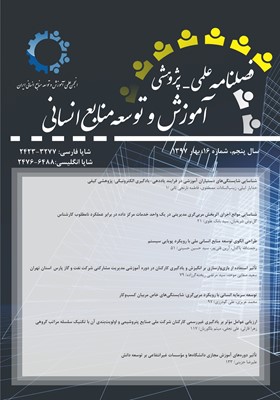طراحی الگوي توسعه منابع انساني ملي با رويكرد پویایی سيستم
محورهای موضوعی :
رحمت الله پاکدل
1
,
آرین قلی پور
2
![]() ,
سیدحسن حسینی
3
,
سیدحسن حسینی
3
1 - تهران
2 - دانشگاه تهران
3 - تهران
کلید واژه: منابع انسانی, توسعه منابع انساني ملی, رويكرد سيستمي.,
چکیده مقاله :
بازطراحي نظامها و فرايندهاي مرتبط با هر يک از آنها مي تواند تأثیر چشمگيري در هدايت و مديريت منابع انساني کشور به سمت اهداف و آرمانهای توسعه کشور داشته و از موازي کاري و اقدامات و فعالیتهای غیر هدفمند و غیر سیستمی جلوگيري نمايد. این مقاله با هدف ارائه الگویی برای تبیین مؤلفهها و نحوه ارتباط و تعامل بين سیاستها، استراتژیها، برنامهها و اقدامات هريک از اين سازمانها و وزارتخانههای ذیربط در امر توسعه منابع انساني طراحیشده است. بر همین اساس مبتنی بر روش اکتشافی از روش گردآوری دادههای کیفی دادههای لازم برای تحلیل بر پایه رويكرد سيستمي و برهمکنشهای بین مؤلفههای توسعه منابع انساني ملي، زیرسیستمها و متغیرهای سیستم استخراجشده است. نتایج این پژوهش نشان میدهد که سیستم توسعه منابع انسانی ملی دارای زیرسیستمهای اصلی تربیت و عرضه نیروی انسانی و بازار کار میباشد. این دو زیرسیستم تحت سیاستگذاریهای زیرسیستم مدیریت منابع انسانی و رشد و توسعه اقتصادی قرار دارند بهعبارتدیگر سیاستهای بخش منابع انسانی کشور بهعنوان درونداد زیرسیستم عرضه و بازار کار نیروی انسانی عمل میکند. همچنین حلقههای علی معلولی بهدستآمده از زیرسیستمهای ششگانه این الگو، متغیرهای اثرگذار و نحوه تعاملات آنها بر روی یکدیگر را ترسیم و بهعنوان مبنایی جهت ارائه راهکار ارائه گردید.
Redesigning the systems and processes associated with each of them can have a significant effect on the guidance and management of the human resources of the country towards the goals and aspirations of the country's development and also prevent parallel and non-systemic actions & activities. This article designed with the purpose of providing a model for explaining the components and the way in which communication and interaction between policies, strategies, plans along with actions of each of these organizations and relevant ministries in the development of human resources. Based on the exploratory method, the required qualitative data for analysis is extracted for analysis based on the systemic approach, the interactions between national human resources components & subsystems and also system variables. The results of this study indicated that the National Human Resources Development System (NHRDS) has the main sub-systems of training and supply of human resources and labor market. These two subsystems are subordinated to HRM and Economic Development. In other words, the HR policies of the country act as inputs for the supply and labor market subsystem. Also, the causal circles derived from the six subsystems of this model, trace the effective variables and how to interact with each other and propose it as a basis for the solution presentation.
